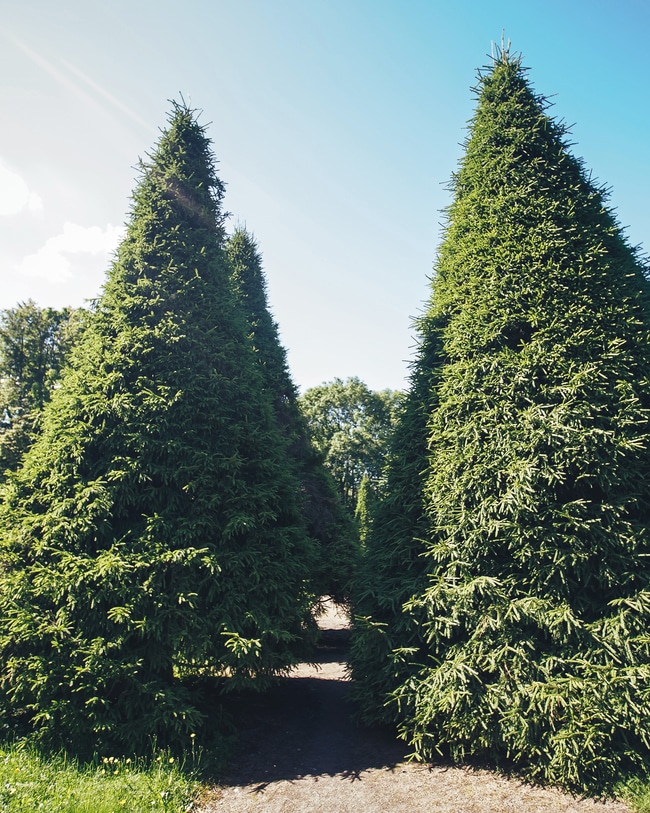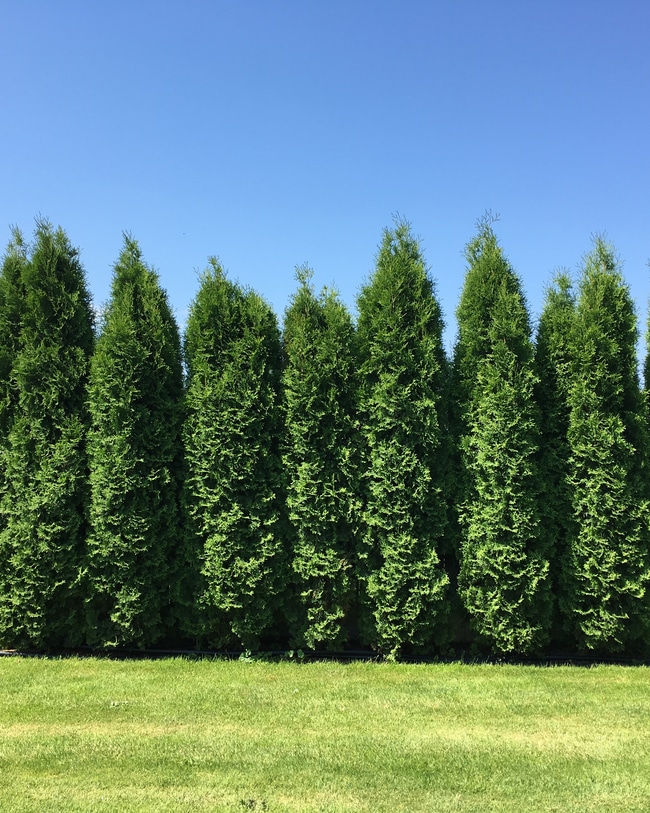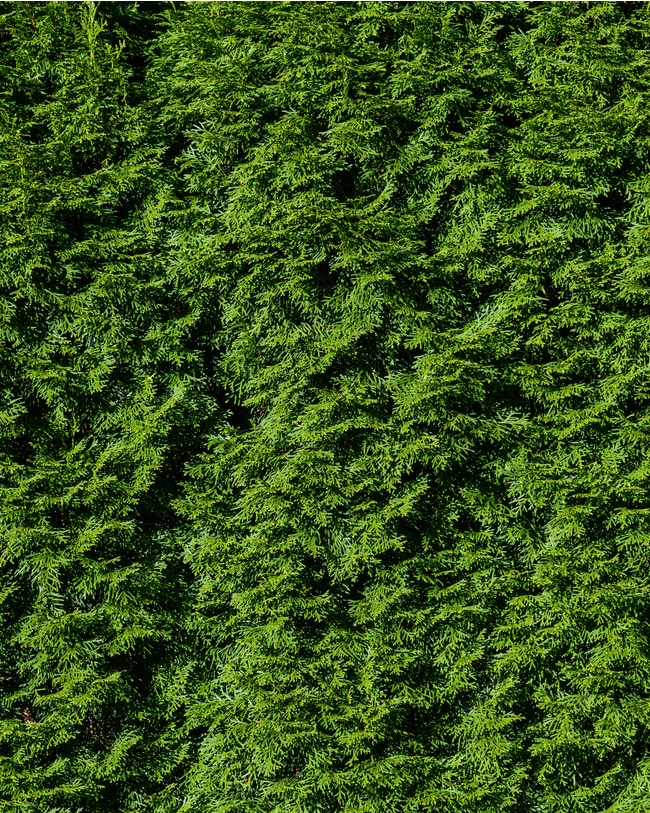Thuja Green Giants are incredible arborvitae plants to use as a hedge plant, a privacy screen, or simply to create a focal point around your yard. These amazing plants are used worldwide for their evergreen green foliage that makes a perfect privacy wall around your property.
Make sure you learn about some of the reasons why your tree may be turning brown. It is important to recognize diseases and pests early.
When you plant one of these arborvitae, you ensure you will have beautiful green foliage throughout the year that continues to grow year after year. These arborvitae trees are adaptable to many different types of soil. These highly adaptable and fast-growing trees can grow at a rate of 3-5 feet per year, continually supplying you with a beautiful privacy hedge year round.
The Thuja Green Giants were introduced to the US National Arboretum in 1965 and has been growing wonderfully in the United States ever since. It is a mix between the Japanese cultivar and American cultivar, which allows it to be resistant to pest problems and stay full and green all year round. These trees are also deer resistant and can be planted in areas all over the country that have wildlife roaming throughout without compromising the life of your trees. These trees got their name from their size and color, which completely explains why they are commonly referred to by the common name, Green Giants.

Tree Details
Size
These incredible plants can reach heights of a whopping 60 feet tall and a mature width of 20 feet across. They continually grow year after year. Their fast growth rate ensures that if you plant these evergreen trees, you will quickly have a privacy hedge that will give your property privacy and protect your home from weather conditions such as high winds.
Planting
Although you can plant your arborvitae almost any time throughout the year, the best time to plant your tree to ensure plenty of growing time is in early spring.
When you are planting a brand new Thuja Green Giant, dig a hole that is twice as wide and twice as deep as the pot your tree came in. Once you have dug your hole, place your tree inside, and gradually add soil. At this time, it is recommended to water your tree so you can make sure it is strong and secure.
After the water has drained, continue to add soil and mound around the base of your tree. After you mound your soil, add an organic mulch, which will ensure your tree retains adequate moisture throughout the year.

Growth Rate
Green Giant plants typically grow at a rate of 3 feet to 5 feet every year and can quickly and efficiently produce a privacy fence with their immense foliage.
They grow best in zones 5 through 9. Because they have such a fast growth rate, make sure to place your Thuja where there is plenty of room. These garden plants can grow in almost any hardiness zone if they have well-draining soil and can act as a hedge of protection and privacy around your property. A tree of this size should be well thought out before planted in the ground to form a hedge of foliage around your home or garden.
With their growth rates being 3 feet to 5 feet every year, your evergreen privacy screen will be in place in your yard in no time. These amazing plants also offer disease resistance and beautiful green coloring throughout the year on top of their fast growth rate, making them a perfect hedge for your home.
Spacing
When it comes to spacing, deciding what area of your property you want to plant your Thuja trees is incredibly important because of their size and fast growth rate. These trees grow 3 feet to 5 feet per year and have a root system that grows outwards, so choosing a location in full sun and with adequate space is necessary.
If you want to create a living privacy wall, choosing an area of your yard with adequate space is imperative. To create a wall of arborvitae, plant your trees in a single row with trees at least 5 feet-6 feet apart.
You can also opt to plant your trees in two rows to create a more substantial wall by staggering your trees. Planting your trees 4 feet apart diagonally and 8 feet apart horizontally will keep your fence looking full and ensure a more significant looking wall.
The growth rates for Thuja Green Giants are incredible, but also not something to forget about when you are deciding where to plant your fast-growing trees in an area of your yard.

You may also want to check out our general arborvitae care guide where we give more details about how to plant and raise them.
Care Guide
Amount of Sun
When it comes to your Green Giant Arborvitae placement, finding an area in full sun will help your trees grow at a steady rate. The Thuja trees thrive in full sun to partial shade, and when they are placed in the correct location, they will remarkable growth rates, growing multiple feet per year.
Watering Frequency
Arborvitaes are incredibly drought resistant once they are established. When they are young and new, it is wise to water your trees every other day for the first couple of months. As your tree continues to develop and grow, you can hold off on watering as frequently. Once they are established, you only need to truly water your evergreen trees when you are having a dry season to ensure they get some water to grow.

Fertilizer Application
Green Giant Arborvitae do well with fertilizer applied throughout the year. Fertilizers that are recommended for these giant trees are slower release and nitrogen-rich fertilizers. It is best to add your fertilizer to the base of your tree every spring to give your trees adequate nutrients for the next growing season.
These evergreen trees can do well on minimal interference, and when they reach a mature height, these plants can reach a height of 60 feet. Adding an adequate amount of fertilizer every spring will encourage your trees to grow a perfect hedge for your home or garden.
If you notice that your arborvitae is browning, don’t immediately attempt to add more fertilizer. A browning tree may represent a bigger issue.
Soil
Thuja aren’t incredibly picky when it comes to soil, but they are not fans of overly soggy or compact soil. Planting your arborvitae tree in waterlogged soil can lead to immense root rot. Choosing a site for your tree where the soil is well-drained helps to protect your tree’s root system and ensure adequate growth for your evergreen trees.
Overall, when it comes to soil, Thuja Green Giant trees can grow in a wide range of soils as long as you ensure you stay away from the extremes of compact or soggy soil, you will ensure adequate conditions for your tree to thrive.
Pruning
Green Giants typically grow in a conical shape throughout the year and will continue to grow taller and wider per year. If you want to shape your arborvitae, they also respond very well to regular pruning, but it is not necessary. If you’re going to shape your plants, then plan to prune them in the early spring every year.

Wonderful Additions to Your Yard
Thuja Green Giant plants are a perfect addition to your garden or yard.
These evergreen trees has many positive attributes, making it a perfect addition to your garden. These plants are deer resistant and are low maintenance. Your garden or yard is sure to benefit from the addition of this beautiful and hardy tree.


No one talks about the maintaining the middle of the bush. Is there anything that needs to be done?
If your bush is too thick, you can thin the branches back to their origins. Or if you want to promote growth, then rune back to the bud and this will promote more compact growth. Generally you don’t need to prune the middle of the bush unless there are dead branches or twigs in the middle.
Can green giants thrive in clay?
Arborvitae Green Giant trees may be able to survive in clay, but the keyword is survive. They won’t grow as robustly as they would if they were grown in soil with better drainage. If you have to grow it in clay, amend the soil with potting soil and compost to try to improve the drainage.
Can you cut the top of the Green Giant back if it gets too tall?
Do you use ground coffee for the trees?